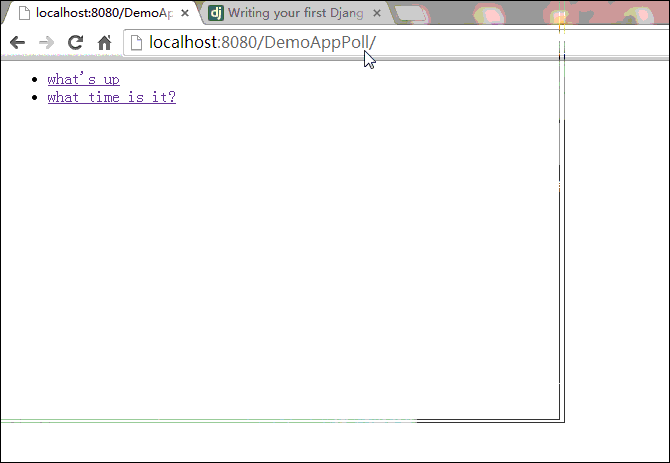- 简单的表单
- 处理表单提交-跳转/错误信息
- 处理表单提交--结果显示
- 通用view (generic view) 设计:越少代码越好?
-
- 1.修改DemoAppPoll/urls.py
-
- 2.修改DemoAppPoll/views.py
简单的表单
DemoAppPoll/templates/details.html
<h1>{{ question.question_text }}</h1>
{% if error_message %}<p><strong>{{ error_message }}</strong></p>{% endif %}
<form action="{% url 'DemoAppPoll:vote' question.id %}" method="post">
{% csrf_token %}
{% for choice in question.choice_set.all %}
<input type="radio" name="choice" id="choice{{ forloop.counter }}" value="{{ choice.id }}" />
<label for="choice{{ forloop.counter }}">{{ choice.choice_text }}</label><br />
{% endfor %}
<input type="submit" value="Vote" />
</form>
转换成源码文件是:
<h1>what time is it?</h1>
<form action="/DemoAppPoll/2/vote/" method="post">
<input type='hidden' name='csrfmiddlewaretoken' value='nEUM2klSzxP2tZFq9oFnVai2MqqUt2z2' />
<input type="radio" name="choice" id="choice1" value="4" />
<label for="choice1">q2 win</label><br />
<input type="radio" name="choice" id="choice2" value="5" />
<label for="choice2">who win</label><br />
<input type="submit" value="Vote" />
</form>
这里有几个要关注的地方:
1> 表单的提交地址,我们写的是{% url 'DemoAppPoll:vote' question.id %},在DemoAppPoll/urls.py里,我们使用
url(r'^(?P<question_id>d+)/vote/$', views.vote, name='vote'
名称为vote来处理这个url匹配,全称需要加上命名空间,就成了DemoAppPoll:vote(http://localhost:8080/DemoAppPoll/2/vote/)
2>forloop.counter,用来显示循环的次数.
3>跨域保护CSRF, {% csrf_token %},自动生成一个隐藏的input.作为校验,保护.
处理表单提交-跳转/错误信息
上面的表单提交后,并没有做有效的处理.
DemoAppPoll/views.py
from django.shortcuts import render,get_object_or_404
from django.http import HttpResponse,HttpResponseRedirect
from django.core.urlresolvers import reverse
from DemoAppPoll.models import Question,Choice
def vote(request, question_id):
#return HttpResponse("You're voting on question %s." % question_id)
q = get_object_or_404(Question,pk=question_id)
try:
selected_choice=q.choice_set.get(pk=request.POST['choice'])
except(KeyError,Choice.DoesNotExist):
return render(request,'DemoAppPoll/detail.html',{
'question':q,
'error_message':"You didn't select choice.",
})
else:
selected_choice.votes+=1
selected_choice.save()
print "question.id=",q.id
print "question_text=",q.question_text
print "selected_choice.id=",selected_choice.id
print "selected_choice.votes=",selected_choice.votes
print "url-redirect=",reverse('DemoAppPoll:results',args=(q.id,))
return HttpResponseRedirect(reverse('DemoAppPoll:results',args=(q.id,)))
首先,根据问题ID,查找问题,确认为有效问题.
然后,根据post信息,判断是哪个选项.
投票的票数增加1之后,网页跳转.
有几个要点:
1>reqest.POST,类字典型数据(key-value).value总是Strngs
2>同理reqest.GET可以从GET方法中获取数据.
3>HttpResponseRedirect(url-to-redirect),网页跳转,仅带一个参数,那就是要跳转到的网页.
这里
4>需要跳转的url,使用了reverse()方法,返回:
"/DemoAppPoll/2/results/"
处理表单提交--结果显示
提交表单后,跳转到"/DemoAppPoll/2/results/",这个页面还没有显示什么实际的内容.
首先需要确认问题,然后指定模版来处理url:
DemoAppPoll/views.py/[fun]results
def results(request, question_id):
#response = "You're looking at the results of question %s."
#return HttpResponse(response % question_id)
question = get_object_or_404(Question, pk=question_id)
return render(request, 'DemoAppPoll/results.html', {'question': question})
下面就需要编写结果显示的界面:
DemoAppPoll/templates/results.html
<h1>{{ question.question_text }}</h1>
<ul>
{% for choice in question.choice_set.all %}
<li>{{ choice.choice_text }} -- {{ choice.votes }} vote{{ choice.votes|pluralize }}</li>
"choice.votes|pluralize"={{ choice.votes|pluralize }}
{% endfor %}
</ul>
<a href="{% url 'DemoAppPoll:detail' question.id %}">Vote again?</a>
"choice.votes|pluralize"=s ,单词加复数的方法.
通用viw设计:越少代码越好?
detail(),results(),index(),这三个views里方法,都代表了一个通用的网页开发过程:
-
根据URL参数,从数据库得到数据
-
加载模版,返回渲染后数据.
更为便捷的方法是,使用"generic views":
- 转换URLconf
- 删除冗余代码
- 使用"generic views."
1.修改DemoAppPoll/urls.py
from django.conf.urls import patterns,url
from DemoAppPoll import views
urlpatterns = patterns('',
url(r'^$',views.IndexView.as_view(),name='index'),
url(r'^(?P<pk>d+)/$',views.DetailView.as_view(),name='detail'),
url(r'^(?P<pk>d+)/results/$',views.ResultsView.as_view(),name='results'),
url(r'^(?P<question_id>d+)/vote/$',views.vote,name='vote'),
)
和之前比较一下:
url(r'^$', views.index, name='index'),
url(r'^(?P<question_id>d+)/$', views.detail, name='detail'),
url(r'^(?P<question_id>d+)/results/$', views.results, name='results'),
url(r'^(?P<question_id>d+)/vote/$', views.vote, name='vote'),
使用<pk>代替了<question_id>
2.修改DemoAppPoll/views.py
from django.views import generic
class IndexView(generic.ListView):
template_name='DemoAppPoll/index.html'
context_object_name='latest_question_list'
def get_queryset(self):
return Question.objects.order_by('-pub_date')[:5]
class DetailView(generic.DetailView):
model = Question
template_name="DemoAppPoll/detail.html"
class ResultsView(generic.DetailView):
model = Question
template_name="DemoAppPoll/results.html"
新导入了包,传入参数也有了变化.
之前是:
def index(request):
latest_question_list = Question.objects.order_by('-pub_date')[:5]
context = {'latest_question_list': latest_question_list}
return render(request, 'DemoAppPoll/index.html', context)
def detail(request, question_id):
question = get_object_or_404(Question, pk=question_id)
return render(request, 'DemoAppPoll/detail.html', {'question': question})
def results(request, question_id):
#response = "You're looking at the results of question %s."
#return HttpResponse(response % question_id)
question = get_object_or_404(Question, pk=question_id)
return render(request, 'DemoAppPoll/results.html', {'question': question})
这里我们使用了2个view:
- ListView
- DetailView
1>每一个"geneic view"需要知道所作用的model.
2>DetailView需要一个 primary key,(pk,关键字).
3>ListView的默认模版是:"app name>/
_list.html"
4>DetailView的默认模版是"app name>/
_detail.html."
为了指定模版而不是默认的模版,给变量template_name赋值.
5>传递变量: quesiton对象,由于使用了modle:Question,需要另外再次传递.
但是,默认提供的的 question_list,我们需要使用的是latest_question_list变量,所以通过
context_object_name='latest_question_list'
这段代码,达到我们的目的.
